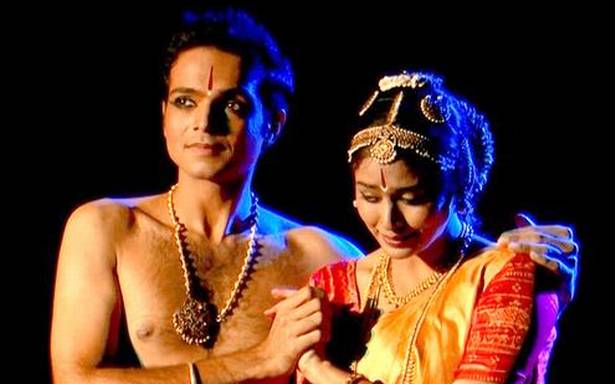Eminent artistes came together to offer rich variety at the GV Ramani Natya Kala Foundation’s online festival
For the past nine years, Gayatri Subramaniam, founder-director, Guru GV Ramani Natya Kala Foundation, (GVRNKF) has been hosting interesting events in Vashi, Navi Mumbai. This year’s annual festival was held online.
The opening event was Meenakshi Srinivasan’s Bharatanatyam performance. She began with an invocatory salutation to Lord Padmanabha. Verses from Kulasekara Azhwar’s ‘Mukundamala’ and Swati Tirunal’s kriti (‘Bhogeendra sayeenam’, Kuntalavarali) combined with sollus and swaras were a beautiful exploration of Srikara on Ksheerasagaram. The pauses allowed ample time for every pose of Vishnu to sink in. The imagery of the procession aided by apt musical notes was a delight.
The Thanjavur Quartet varnam (‘Sarasa Ninnu,’ Karnataka Kapi, Rupakam) was a sensitive interpretation of sringara bhakti. The nayika’s intense longing for union with Lord Brihadeeswara as a lover and devotee at once was brought out seamlessly. The unhurried delineation of her pangs, chosen episodes and the various Shiva stances contributed to the visual gratification. In the Sarangapani padam, the nayika pretends that she does not know Krishna and asks for his name. Though startled at first, Krishna decides to play along, and lists his different names.
Graceful presentation
Music for this padam was by K. Hariprasad, set in raga Nattakurinji, misrachapu talam. The entire presentation, from Krishna’s point of view, was embellished with intermittent reactions of the nayika. Blessed with lithe deportment, Meenakshi carried off her recital with grace and charm. The costumes were neat and compact. By fine-tuning the prayer song and intermittent overtures, Meenakshi could have squeezed in a brief thillana.
The orchestra featuring Hari Prasad (vocals), Jayashree Ramanathan (nattuvangam) and Vedakrishna Ram (mridangam), Ishwar Ramakrishnan (violin) and J.B. Srutisagar (flute) enhanced the performance.
Intelligently choreographed
Seven dancers of Leela Samson’s Spanda Dance company presented ‘Nokkam,’ intelligently choreographed, with abstract and symbolic pieces and traditional and contemporary content.
In ‘Bhaskaraya Namah,’ the dancers paid obeisance to the Sun with agile movements. The play of light, the chanting, surya namaskar, the synergetic feet-tapping sound — it was an invigorating amalgam.
‘Athishay’ portrayed the amazing feat of Krishna vanquishing the Kalinga. The quick successive movements of the dancers represented the serpent’s hood with Krishna surmounting each of them in turn. In Purandaradasa’s ‘Aadidano Ranga,’ the villagers celebrate Krishna’s conquest through song and dance. The transition from one raga to another — Charukesi, Hamsanandi and Bhimpalas — was smooth.
The next piece eulogising the river, music composed by Rajkumar Bharati, was set in varnam mettu. The lilting gait of the river, the generosity of nature, the disconnect between man and nature, forgetting the five senses, were all conveyed in ‘Nadhi, nee endrum vaazhi.’ The singing in different octaves and swaras depicting the river flowing was appealing.
The chota khyal of Kumar Gandharva juxtaposed Dvaitam and Advaitam. On one side of the stage two lovers, in a pool of light, awaken to the dawn of a new day while on the other side a couple await in dusk the onset of night. Two dancers represent Bhogta and Drishta, the two birds from the Vedas symbolising man veiled and unveiled at once. The contrasted light and silhouette effects were exemplary.
Swarnanjali, the concluding thillana, in raga Purvi was a celebration of rhythm, the evolution of seven swaras, the colours, animals and rasas they represent, culminating in the pranavartha, worship of Brahma beyond form and religion. The dancers, backed by their training and rehearsals, did full justice to Leela Samson’s innovative choreography in their individual and collective capacity. The introductions by Leela before every piece were interestingly done on faded images of the dancers.
Blend of styles
A brief impactful invocation by senior Carnatic vocalist Sikkil Gurucharan set the stage for ‘Shivamritadhaara,’ a thematic collaboration with Bharatanatyam duo — Renjith Babu and Vijna Vasudevan. An impressive entry as a river flowing, the traditional mallari where Vijna walked with sedate steps with the kumba while the agile Renjith donned several roles including Nandi, the drummer, etc., depicting the procession. Well-executed jatis segued into ‘Jambupathe.’ The involved emotive singing by Gurucharan and the nuanced portrayal by the duo made it an audio-visual delight.
The Bahudari raga alapana with a lilting tanam and intelligent niraval for the kriti ‘Sadanandathandavam’ created a comprehensive experience. This allowed scope for a melodious violin display by Ishwar and a scintillating thani by Sumesh.
Moving back to the collaboration, the duo presented ‘Nagendraharaya’ defining the panchakshara. Beginning with the imagery of the eight snakes moving through the chakras, the description for each akshara was detailed and communicative. Gurucharan was at his best while singing this piece and Renjith found ample scope holding relevant yoga poses.
Gurucharan’s next was a padam in Nilambari, set to misrachapu tala. This composition by V.P. Dhananjayan was a lullaby sung by a mother to a child as she waits for her husband. The concluding thillana began with melodic notes on the violin by Ishwar Ramakrishnan. Beautifully co-ordinated nritta was followed by sensitive abhinaya.
The verve and diction of Sikkil, combined with Sumesh Narayanan on the mridangam and K.S. Balakrishnan on the nattuvangam added value. The colour co-ordinated costumes in light and dark blue were appealing. The duo should be credited for the apt use of hasta mudras, their research and suitable role reversals.
Videography and editing by Iyappan Arumugam and event coordination by Varsha Kumar were noteworthy.
The Mumbai-based author
writes on music and dance.
Source: Read Full Article


